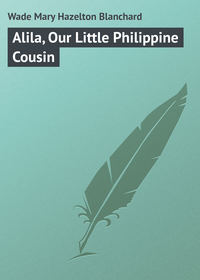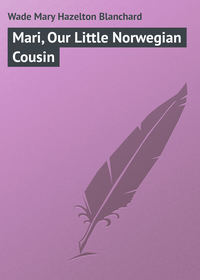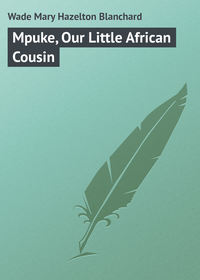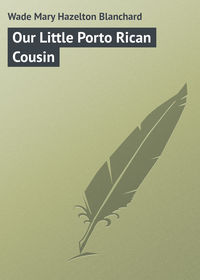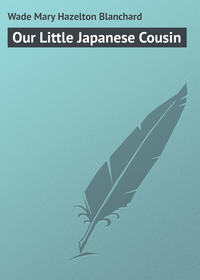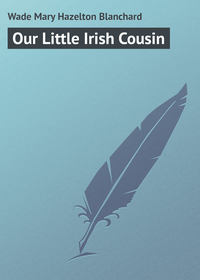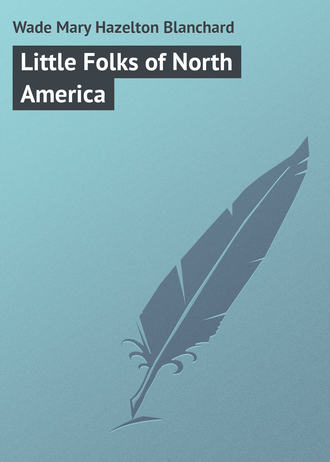 полная версия
полная версияLittle Folks of North America
Before they venture from their homes their loving mothers see that they put on their bird-skin shirts with the soft feathers worn next to the skin. Then there are stockings of hare or dog skin, and high boots of sealskin.
It would be rather hard at first for you to tell an Eskimo girl from a boy for all the people of the snowland wear trousers which are, of course, much warmer than skirts would be. These trousers, like the boots, are made of heavy skins with the fur on the inside.
The upper part of the body is covered with a short fur blouse. A fur hood and mittens complete the outdoor dress. No suit could be better for traveling over the snow or playing on the icy hillsides than the Greenland mothers make for their little ones.
Hunting for FoodSometimes the little Eskimos and their parents feast nearly all day long. This is when their fathers have been successful in the hunt and there is plenty of seal and walrus meat on hand. But there are other times when many hours pass by without food and they do not know how much longer they must wait before they can satisfy their hunger.
Sometimes the men are away from home for days together, searching the shore for the food their wives and little ones need so much. When at last they have been successful and returned with their loads, the children run out with their mothers to meet the hunters and take care of the precious prize. The women are armed with long knives with which they quickly cut away the skins. The meat is cut up, and with shouts of laughter the children crawl through the narrow passage into the hut and gather around their mothers, as pieces of the meat are placed in stone dishes and hung over the lamps to cook.
It may be, that while the children sit eagerly watching for some seal-blood soup to be prepared, the women throw them pieces of blubber which they eat greedily.
All this time the men are stretched about on the low platforms, joking and telling stories while they wait for the feast to begin. As they wait, some of them busy their fingers carving toys out of walrus-teeth for the children, – tiny reindeer, seals, sledges, birds or muskoxen.
When the dinner is ready a large dish of food is placed in the middle of the floor, the big folks and little sit around in a circle and help themselves with their fingers. After dinner come songs and dances in which the children take their part.
It is very likely that over on a low shelf a mother dog is lying with her puppies, and the children go to her from time to time and play with their cunning little pets. The Eskimos are fond of their dogs, and are very careful of the puppies, which are brought up in the house with their own children from the time when they are born till they are big enough to take care of themselves.
Eskimo DogsThe boys and girls of the far north would be very lonely without their trusty dogs. They play with the puppies during the long winter days. Then, as soon as their little pets are old enough, the boys begin to train them. First, the animal must be taught to obey their young masters. Then collars are made, and with long straps of leather, these are fastened to low sledges made of drift wood and walrus lines. The sledge is drawn by a number of dogs, each of which is fastened by a separate strap.
When the master of the pack is ready for a ride, he throws himself upon the sledge, cracks his whip, and the dogs start wildly off with leaps and bounds.
On goes the sledge, now over a smooth sheet of frozen snow, and again bumping up and down as the dogs dash over rough hillocks of ice. It is enough to take one’s breath away.
An Eskimo boy is much pleased when his father tells him he is getting old enough to have a team of dogs for his very own. He picks out the brightest and smartest one of his puppies to be the leader of the new pack and trains him with the greatest care. The young dog in his turn seems proud of the honor paid him and soon begins to rule among his fellows like a king.
Poor Eskimo dogs! They have a hard lot. All through the long winter they are seldom fed more than three or four times a week. Only the mother dogs with their puppies are allowed in the house. The rest of the pack spend most of the time outdoors although they are sometimes allowed in the passageway, or a snow hut is built for them near the house of their master. Their hair, however, is long and thick and warm, and this protects them from the winds and storm. They will stretch out on a bed of snow and sleep comfortably hour after hour in the coldest weather. One of their favorite resting places is the top of their master’s hut; but when the wind blows hard they prefer to creep into their snow house and stay there till the weather is once more calm.
As soon as the Eskimo boy is old enough to hold a tiny bow his parents put one in his chubby hands. He is so pleased when he is able to set an arrow and send it speeding against a mark on the wall of the hut. When he strikes it for the first time the place rings with his shouts of delight. When he is a little older he takes lessons from his father in shaping harpoons and spearheads. He is now getting ready for the hunting that is to be his work in life.
While he is learning the ways of a hunter, his sister also has her lessons. Her mother and grandmother are busy women, tanning the skins the men bring in, and making them into warm garments for the family. The girls must therefore learn to sew with coarse bone needles and heavy thread made from the sinews of the reindeer. They must also help in chewing skin with their strong white teeth. This is to make the skin soft and comfortable for the wearer, but it is a long, hard task. Many an Eskimo woman wears her teeth down to stubs by the time she is an old woman.
After Seals.
When autumn sets in, the head of the family watches the ice in the bay. As soon as it is frozen hard enough, he will begin his hunt for seals. He clothes himself in fur from head to foot, takes his lance from the wall, and hangs over one arm a little stool made of small pieces of wood bound together with leather straps. He must not forget his hunting knife, nor a fur blanket which he throws over his shoulders. At last he is off. He walks quickly down to the edge of the bay and looks keenly about over its surface. Perhaps he decides to follow the coast for some distance, as farther along the ice seems firmer.
On he moves till he comes to a place where he can trust himself. With leaps and bounds he springs from one cake of ice to another till he reaches a place where the water of the outer bay is frozen solid. He keeps his eyes fastened on the ice. Ah! he has discovered a small hole. He thinks, “Now I have found the home of a family of seals. This is certainly their breathing place.”
He spreads his fur blanket on the ice close to the hole. In the middle of it he puts his stool, and then, with lance in hand, he sits down to watch and wait.
It may be that in a short time a seal’s nose will appear at this hole to get a breath of fresh air, or perhaps hours will pass before this happens.
At last the watching hunter is rewarded. He thrusts his lance suddenly down through the hole, and if he has made no mistake it has pierced the seal below. The lance disappears under the ice, but the hunter has taken care to fasten leather lines to the blunt end, and this he holds tightly in his hands.
Now he must be very careful. He takes his hunting knife from his sheath and carefully cuts away the ice from around the breathing hole. He must make a place so large that the seal’s body can be drawn up through, to the surface. At last his prey lies before him but the animal is still alive and must be killed.
As soon as this is done, the man hastens back to the shore near his home where some of his faithful dogs have been harnessed to the sledge and are patiently awaiting him.
He unties the strap by which they are fastened to a rock. Then, with delighted howls, the dogs rush along with their master to the place where the dead seal is lying. It is placed on the sledge, and in a short time is in the hands of the hunter’s wife, who takes off the skin and cuts up the meat for the hungry family.
Nannook, the BearDuring the long evenings the children are never tired of listening to the stories of the big white bear. It is Nannook who makes her winter home against the side of a steep cliff. Here the snow drifts about her and shuts her in from the outside world; at the same time the warm breath from her great body melts the snow next to her, leaving a small empty space. Here she sleeps and here her little cubs are born.
Sometimes the bear is caught by means of a trap which the Eskimo hunter has built of stone set up in a square. There is a small opening inside of which a piece of blubber is placed. When Nannook snaps at the blubber, down falls a heavy stone and the animal is made a prisoner.
Sometimes the hunter comes upon the track of a bear when he has no companion except his trusty dogs. But he is not afraid. He urges them on and the sledge dashes along with the greatest speed. The master of the team hardly needs to guide, for the dogs are eager to follow the scent. And now the prey is in sight. Perhaps it is a mother bear with two cubs. She sees her enemy and turns to flee, but her little ones cannot run fast and she stops again and again for them. Every moment the dogs are gaining upon her. At last she sees it is of no use and takes her stand to meet the attack.
The team is upon her now. The hunter leaps from the sledge and rushes towards the mother bear with spear in hand. She rises upon her hind legs and opens her mouth with an angry growl. One blow of her paw would be enough to kill the man if he gave her time to strike, but he makes a sudden thrust into her heart with his spear before she has a chance to do this.
It may be that the spear fails to reach its mark, or that the bear breaks it with one angry blow. She is furious now, and it would go hard with the hunter if the faithful dogs were not already springing upon the huge animal like a pack of wolves. With their help she is overcome, and falls at last dying to the ground. Then it is an easy matter to kill the poor little cubs, which all through the fight have been crying piteously.
Many a time an Eskimo hunter has met his death when on a bear hunt. Many a time, too, he has received fearful wounds that have made him a cripple for the rest of his life. Yet he is a brave man and is ever ready to join a hunt in search of Nannook, the big white bear.
After the WalrusThe Eskimo boys are not only eager for bear stories, but they love to hear their fathers tell of the battles with the big walrus, whose home is in the sea. It weighs nearly a thousand pounds. It has a thick, tough skin, and long tusks of ivory. When a number of walruses are together they will often turn on the hunters with fury. Then the men must move quickly and fight bravely, or they may lose their lives.
The best time for a walrus hunt is when the moon is shining brightly. The children look on eagerly while the men get knives and lances ready, for perhaps news has just come that walruses have been seen on the ice floes miles away up the coast. The dogs are harnessed to the sledges and the party start off.
One, two, and even three days may pass with no sign of the returning hunters. At last the sound of barking dogs is heard in the distance. The women and children rush out of the huts, and if the moon has set or the clouds have hidden her light, they carry torches and hurry to meet the hunters.
The news may be good and the sledges loaded with ivory and walrus meat. But perhaps the men have not been successful, and have only to tell of a long search, with no prize gained. It may be that one of the men has been wounded by an enraged walrus, or has been drawn into the icy water and has narrowly escaped drowning. At any rate, there is much to tell to the eager listeners.
A walrus is much larger and heavier than a seal. Besides this, it has two strong tusks with which to defend itself; and although it is hunted in much the same way, it is far more dangerous work to kill a walrus and land it safely on the ice. One man seldom hunts walruses alone.
The NarwhalEskimos never live far from the shore. It would not be safe to do so, for most of their food is obtained from the sea. Besides seals and walruses, other large creatures are hunted there. There are different kinds of whales; there are porpoises and swordfish; more important still is the narwhal with its long ivory tusk pointing straight out from its head. It is an ugly-looking creature, but the Eskimos think only of the beautiful white ivory and the oil to be obtained, besides abundance of delicious meat.
As soon as November comes, the men begin to look for narwhals. A party of hunters get into their boats and paddle out into the deep waters of the bay. As they paddle along, as soon as a narwhal appears in sight they hurry toward it with all the speed possible. Each one is eager to be the first one to attack, for he is the one to receive most honor when the fight is over and the prize gained. Great care must be used as the hunters draw near the narwhal for that long tusk could make a hole through a boat in an instant.
SpringtimeThe long winter is over at last. The men have hunted many of the days, but they have spent much time making lines and traps for the warmer days to come; also in mending and sharpening their weapons. The women have been busy making clothes for the family and tending the lamps, while the happy, loving children have helped their parents a little, but mostly they have been coasting and playing games on the snowfields. They have paid visits to friends in other villages; they have had many a feast; sometimes, alas! they have gone without food for days at a time. They have sung and danced, and watched the beautiful northern lights flash over the sky. They have listened to legends of their big brother, the moon, and his sister the sun. Sometimes, too, they have heard stories about the great ice-sheet that stretches all over the mountains and plains of the inland country. They trembled as they were told that terrible beings have their home on that inland ice and they are quite sure they would not venture there for the world.
Now that spring has come, they are ready for a season of sunshine. They are glad, too, to seek a new home and new adventures. Yes, the spring has come and flocks of birds are flying overhead to bring the good news.
The boys help their fathers take off the roofs of the winter houses and open them up to the sunshine and fresh air. All the people in the village are going to move.
Skin tents are packed on the sledges, together with lamps and the few stone dishes they possess. For four whole months the Eskimos will camp out and move from place to place in search of reindeer and birds on the land, or fish in the waters of the bay.
Sometimes in the early spring or fall the Eskimo children live in still different homes from their winter huts of stone or the summer tents. These are the snow houses, which the men can build very quickly.
If they are off on a long hunt, these snow houses are useful, for they are warm and comfortable in the worst storm or the coldest weather. Big blocks of solid snow are cut and piled up in the shape of a bee-hive. A small doorway is left open which can be filled with another snow-block when the people wish it. When the house is finished loose snow is sifted over it and every crack filled up so that the wind cannot make its way inside. The stone lamp is set up in the middle or at the side of the hut. A bench is made of snow and covered with furs, and the family are ready to go to housekeeping.
As soon as the Eskimo children see the birds flying in the springtime they begin to think of the fun they will have hunting for eggs. The boys get their bows and arrows ready at this time, for they will shoot dozens and dozens of the birds before the summer is over.
There are many kinds of these birds, most of which like to build their nests on the sides of steep cliffs along the shore. Best of all are the eider ducks with their soft and beautiful feathers. Shirts of eider-duck skin with the feathers worn next to the body are the best and warmest of all, both for the babies of the household and their fathers.
An Eskimo hunter will climb up the sides of the steepest cliff in his search for birds’ eggs. If he lose his foothold, he may fall a great distance and be dashed to pieces on the rocks below. But he does not seem to think of danger. His one idea is to get something good on which his family and himself may feast.
The Skin-boat, or KayakThe boats of the Eskimos are called kayaks and are like no others in the world. The boys take many lessons before they can be trusted to help in making a kayak. It is long and narrow and has room for only one person. Its frame is of bone or wood and it is pointed at both ends. When it is finished, the boat-maker stretches over it a seal skin which his wife has tanned. It is an excellent covering, for the water cannot pass through it. In the middle of the top the man leaves an opening as large as his body is round. He steps inside and sits down, stretching his legs in front of him. Yes, the opening is of the right size; the water of the wildest sea cannot enter and sink the boat when once the Eskimo has fitted the rim around the bottom of his coat over the rim he has made about the opening in the skin covering. With his stout paddle he will dare to travel for miles over the rough sea.
The short summer-time is one long day, for the sun does not set. The children go to bed when they are tired and sleepy and get up when they please. They feast to their hearts’ content during this time, for there are usually fish and birds and eggs in plenty. Then, too, these children of the north go berrying and bring home many a dish of delicious black crow-berries.
The greatest dainty of all is the paunch of a reindeer’s stomach. It consists of the moss and shrubs the animal has eaten, and is a little acid. It is no wonder then that the Eskimos are fond of it, as they have neither bread nor vegetables, and no fruit except the berries they are able to pick during a few weeks out of each year.
The ReindeerAs soon as the spring opens the older boys look forward to the hunt. Perhaps a herd of reindeer has been seen not far away, and the hunters start out over the fields still well-covered with snow to look for traces of them. They carry bows and arrows, also knives. They must not forget to take fur soles for their feet, too. As soon as they are within range of their game they will bind these soles under their kamiks so that the reindeer cannot hear them as they draw near.
Even now the herd may take fright while the hunters are still too far off to shoot. Then thud, thud, sound their feet as they scud away over the fields. But the hunters will not despair even then. They will give chase for hours together if it be necessary.
Sometimes the keen eyes of the Eskimos will find only prints on the snow to show that a herd of reindeer has been lately feeding there.
“We will stay here and watch for them to return,” they say to each other. Then they go to work to make a little fort of stones, behind which they sit down to watch and wait.
They may have to stay there a long time before the sound of reindeer hoofs is heard, but they are patient. They amuse each other with story-telling and the hours pass quickly.
At last a herd draws near. The antlers of these Arctic reindeer are broad and branching. They plant their short legs firmly on the ground as, with heads bent down, they search for moss beneath the snow. They seem to know just where to paw away the snow to find the food they love.
The right moment comes and the hunters send their arrows flying into the midst of the herd. One of the reindeer falls to the ground while the others dash wildly away.
When a number of animals have been killed in a hunt and there is too much meat to carry at once, some of it is buried under a pile of stones, so that the wolves and foxes cannot get it. Then the hunters trudge home for the dog team to help them.
New SettlersYou remember that Eric the Red went to live in Greenland before a white person had stepped on the mainland of North America. You also have learned that his followers lived in Greenland for a long time and then disappeared shortly after they met with the Eskimos.
From that time no more white people went to Greenland till the year 1585, when an Englishman named Davis sailed for many miles along its coast and visited among the Eskimos. Then he went away.
After his visit, there were no settlers from other lands for nearly a hundred years. Then a good minister in Denmark left home with his wife and children and went to a place in southwestern Greenland which he called God Havn or, Good Haven. Hans Egede, for this was the minister’s name, wished to teach the Eskimos the Christian religion.
He had hard work before him. A long time passed before he could understand the strange words of the Eskimo language and the only way he could teach the people was by the pictures he brought with him. Yet he stayed in Greenland for many years and his own children grew up with the little Eskimos for playmates.
Then Hans Egede’s wife died and he went back to Denmark. By this time, however, he had a grown-up son who loved the work his father had begun. He said, “I will remain here and keep on with your teaching.”
So he stayed. Other people from Denmark joined him, and now there are several settlements of Danes in Greenland. They have brought lumber with them with which to build their houses, as well as furniture and dishes from their old home across the sea. Even the sound of the piano may be heard now in this frozen land of the north. Tiny gardens have been dug where a few vegetables are raised each summer. Best of all, churches have been built where Eskimo children sit side by side with their fair-haired brothers and sisters of Denmark.
Once in a while a ship draws near bringing papers and letters, canned food and clothing from across the sea. It is a time of great excitement for the settlers. They have been getting ready for the coming of the ship for a long time, filling vessels with oil and fish, and packing the furs they have got in barter from the Eskimos. All these things are to be sold in other lands, besides many tons of cryolite which is very useful in making aluminum. The white settlers get it from a large mine and receive a good price for it, since Greenland and one other country are the only places in the world where it can be obtained.
Although the Eskimo children of southern Greenland have white playmates among them, yet above them in the north there is many a little village where people from other lands have never been seen or even heard of.
CHAPTER III
Little Folks of Alaska
The Coming of BehringClose your hand together tightly, leaving the forefinger pointing straight out. You now have before you the general shape of the peninsula of Alaska, which lies in the northwestern part of North America.
The children of Alaska have a much more comfortable home than the little Greenlanders. Their shores, except in the far north, are not bound in ice the year around; the winters are not so cold and the summers are warmer; trees grow in thick forests over a great part of the country, and many flowers bloom there.
The reason for this is, that warm winds blow over the country from the west, and these winds are due to a broad stream of water flowing through the Pacific ocean, called the Japanese current. It makes its way from the south and keeps its warmth during its long journey through the colder waters of the main ocean. And so it is that the children of Alaska who feel the warm winds blowing eastward from the Japanese current, do not need the heavy furs worn by the Greenlanders, neither do they require as much fat meat to give heat to their bodies, nor as close and stuffy homes to live in.
The boys and girls of Alaska belong to several different races. There are the yellow-skinned Eskimos of the far north and west; there are the copper-colored Indians who are found in the south, and along the banks of the rivers of the inland country; there are the Aleuts, who live on a chain of islands stretching westward towards Asia, and who are like Indians in some ways and like the Japanese in others. No one really knows what these Aleuts are, nor where they came from. Perhaps in the long-ago they made their way to these islands from Asia, for the distance is not great, and small boats could have crossed over safely in good weather. Besides these Aleuts and the Indians and Japanese, there are white children from the United States whose fathers are busy trading for furs or digging gold in the mines.


